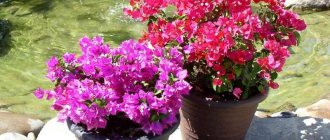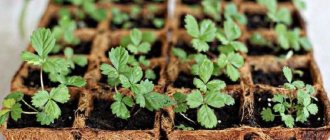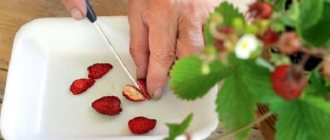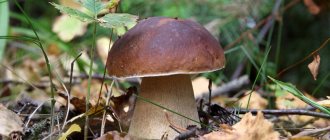Delicate beauty eustoma
More and more often, specialized stores began to sell a flower very similar to a rose, but without thorns. And as a potted plant, and in bouquets and flower arrangements. This is eustoma, which is also often called Irish rose or lisianthus. One strong and branched plant can produce up to 30-35 beautiful and large flowers.
Its natural habitat is the tropics, so the plant requires special conditions to grow in our latitudes. As an annual plant, eustoma can be grown in open ground, but with preliminary forcing of seedlings in greenhouse conditions. In greenhouses and at home, it can live and bloom like a perennial.
Eustoma - large-flowered foreign guest
Lisianthus, “Texas bell”, “Irish rose” - these are the names of eustoma, whose homeland is Central America. The annual, biennial and perennial flower is common in the southern United States, on the Isthmus of Panama, and in Mexico. Lisianthus belongs to the Gentian family; in some European countries it is one of the top popular “bouquet” flowers.
Eustoma flower
Attention! Lisianthus is very similar to a rose in shape and variety of colors. It differs from the queen of flowers in the absence of thorns.
The diameter of a lisianthus flower is 7-8 cm, it is considered a large-flowered plant, its shape is similar to a classic rose. A branched bush with one strong stem can grow a whole bouquet - up to 35 buds!
Pink terry eustoma
Tall varieties of eustoma (up to 90 cm) are grown in greenhouses for cutting, while low-growing ones (up to 30 cm) are more suitable as potted and border plants for a home or plot.
Important recommendations from florists
- First, they decide on where to grow eustoma: if they plan to plant it in the garden, then take a tall variety, otherwise, feel free to buy a short one as a pot crop. The height of the future flower is checked on the seed packaging.
- They also choose based on the climatic conditions of the region, because precipitation and the number of sunny days are important indicators for our capricious plant.
- Pay attention to the longevity of eustoma: it can be one-, two-, or multi-year.
For those who are about to experience growing for the first time, experts recommend hybrid varieties, since they are particularly resistant to many negative factors and have increased immunity.
We wish all lovers of these truly royal flowers strength and patience, and in the summer your eyes will be delighted by the graceful buds of eustoma!
Variety of lisianthus varieties
Eustoma can be white, pink, blue, lilac, violet, purple and even white with different edgings.
Non-double varieties and series of “Irish roses”:
- “Kyoto” F1 (“White”, “Picot Blue”, “Picot Wine Red”, “Picot Pink”;
- white, pink and purple and other colors “Twinkie” F1 and “Mermaid” F1;
- "Blue Chip"
Eustoma terry
Terry varieties:
- Aurora;
- “Echo” F1 (“Yellow”, “White”, “Pink”, “Champagne”, “Lavender”, “Blue Picoti”);
- "Cinderella" F1.
- "Double White"
Breeders from different countries continue to breed different varieties of this incomparable flower.
Planting in open ground
The plant develops best in windless areas in light partial shade. The soil needs to be loose, without stagnant water. First, the soil is dug up onto the bayonet of a shovel and mineral fertilizers are added, such as azofoska, nitrophoska and others. If the soil on the site is highly acidic, be sure to add dolomite flour or wood ash, since neutral soil is preferable for eustoma. After applying the fertilizer, the soil is thoroughly mixed to evenly distribute the components.
Then they make holes and plant the seedlings in such a way that, after filling with soil, they are no deeper than when they were growing in the pot. The soil on the surface is slightly compacted and the plants are watered abundantly, avoiding contact with the leaves. To prevent the soil from cracking as it dries and retaining moisture longer, the plantings are mulched with peat.
Soil suitable for planting eustoma
Experts say that lisianthus is quite demanding in agricultural technology, in temperature, water and ventilation conditions, as well as in mineral nutrition.
Attention! The secret to successfully growing a delicate flower is in the air. It should be fresh, warm and moist.
The soil for seedlings must also be special; there are several options:
- garden soil, coarse sand and humus in a ratio of 1:1:1. You can add a little lime.
- peat with a small amount of sand or perlite;
- light peaty soil with the addition of pieces of charcoal or tree bark humus;
- ready-made soils for violets or saintpaulias.
The soil should be moderately moist, not dry or waterlogged.
Plant eustoma on April 1st.
One of the main inconveniences for beginners in growing eustoma is that it grows slowly. In order to see flowers in July, seeds are planted for seedlings in December-January. And if you have not yet encountered the slowness of this beauty, then you will experience it first-hand in the first year.
Another important fact less known is that although the plant's flowers love the sun and do not tolerate cold weather, its roots thrive and actively develop in cool weather, resulting in a strong, generously flowering bush.
Experienced gardeners recommend planting eustoma seedlings in the ground on April 1, regardless of the spring weather. Tiny rosettes of leaves hug a lump of earth and are therefore well protected from frost. If the weather is particularly cold, you can cover the planted seedlings with film, but this happens extremely rarely. This early planting gives the plants plenty of time to grow before the sweltering summer heat and also gives them a slight timing advantage over tenacious summer weeds.
How to grow eustoma from seeds.
And although most summer residents grow their seedlings themselves, experienced gardeners advise abandoning this approach for eustoma and buying seedlings - this way you will save both time and nerves. But if you do not have such an opportunity, we will tell you how to grow eustoma from seeds yourself.
The seeds of this flower are similar to petunia seeds - very small, covered with a dense shell.
- We sow eustoma from late February to mid-March . Don’t delay, if you sow the seeds at the end of March, you may not see flowers until August. February seedlings will bloom in July.
- It is better to take Violet Soil as soil for seedlings - it contains the acidity we need and a small percentage of nitrogen.
- The temperature for germination of seedlings is +20 degrees during the day and at least +14 at night.
- Be sure to illuminate the seedlings so that their daylight hours are at least 12 hours, because The plant is light-loving and the seeds germinate in the light. It is better to use a special phytolamp for this.
- The containers for planting are the same as for ordinary seedlings - it can be a ready-made plastic greenhouse with cups with a transparent lid or even an ordinary glass jar with a lid.
- How to plant eustoma seeds. We moisten the soil in the cup (jar) by 2 cm and pour the seeds on top, without deepening them, but lightly pressing them against the soil. We remind you that seeds germinate in light. Cover with a lid or film and place in a warm, bright place.
Why does eustoma not sprout?
Be patient. The first point shoots appear after 14 days, and after another 14 days the first true leaf will appear. When 3-4 true leaves appear, we make the first pick (if your seeds all grow in one container). The second picking is carried out when there are 5-6 leaves. It is better to water the seedlings through a tray or with a spray bottle with water at room temperature of 26-28 degrees. Avoid overwatering.
What to feed. We feed eustoma seedlings once every two weeks with a full range of mineral fertilizers for flowers; we do not do this immediately after picking, but wait 14 days before feeding.
Technology for sowing eustoma seeds
It will not be possible to grow the “Texas bell” by division, since the roots of the flower are very delicate, and the transplanted stepson will wither. Cuttings are also not suitable; the cuttings do not produce roots.
The only sure way is to germinate the seeds of the plant. An adult flower is easily pollinated and produces a capsule with a huge number of small seeds of high germination capacity.
Eustoma seeds
Attention! At first, the growth of seedlings is little noticeable, and gardeners think that something is wrong. You just need to wait, since the growth of a flower begins with the formation of a root system. Be prepared for the root to appear in 10-12 days.
Stages of action when sowing seedlings:
- Prepare a deep container.
- Place drainage on the bottom, then sterile soil. Gently smooth it out and moisten it.
- Eustoma seeds are tiny, so they are sold in the form of pills. When planting, the seeds should be evenly placed on top of the soil.
- Cover with glass or film to obtain a greenhouse effect.
- It is better to pour water into the pan before the shoots appear, otherwise the liquid will simply wash away the seeds.
Seedlings should be regularly opened slightly to ventilate and remove condensation. The optimal air temperature for seedlings is 21-24°C during the day, 18-20°C at night. Increasing the temperature is not recommended, as sockets may appear.
Germination of eustoma seeds for seedlings
During the growth period, plants are sprayed with phytosporin to protect against blackleg. Fertilizing with epin, zircon, fertilizers with a calcium base and other types of complex fertilizing is effective.
Careful picking is carried out after 6-8 weeks, transplanted in bunches of 3-4 sprouts. Later, you can dive again, planting one at a time without disturbing the earthen coma.
Eustoma seedlings
Features of growing eustoma lisianthus
Reviews:
LYUDMILA NIKOLAEVNA
writes: can I buy austoma seeds from you?
Sasha Voytyushenko
writes: Good afternoon, please tell me what varieties you have planted and whether you grow the seedlings yourself. Thank you very much.
Viroshuvannya in Teplitsa
writes: Good afternoon! I saw in you a video on Eustoma Viroschuvani. I am very interested in the devices you offer. You provide instructions for used ones. When Which drug should I use? Do you send deliveries to Ukraine?
Zaniya Zagrtdinova
writes: Hello, very interesting. Please tell me. Do you have low-growing varieties? I thought they grew tall. For cutting.
LYUDMILA NIKOLAEVNA
writes: can I buy austoma seeds from you?
To grow eustoma, you can use the seed propagation method. The seeds themselves are very small; they begin to be sown in mid-March. The soil is sterilized and placed in small pots. The seeds are scattered on the surface of the soil, water for irrigation is poured exclusively into the pan, because with ordinary watering the seeds will simply be washed away.
After planting, the pots need to be covered with a translucent film, creating mini-greenhouse conditions. The temperature at night is needed at 18 degrees Celsius, and during the day at 23-25 degrees. The seedlings should be ventilated regularly by lifting the film for a short time.
In protected soil conditions, eustoma prefers warm and moderately warm conditions with moist and fresh air. Therefore, it grows well in greenhouses and conservatories. At home, eustoma is usually kept in winter gardens and insulated loggias. However, it is necessary to take into account: in small, slightly open rooms with dry air, lisianthus develops poorly. It withers and then, usually, dies.
For eustoma, western or eastern placement is preferable. Plants require bright, diffuse lighting. Lisianthus responds well to additional illumination with a combination of fluorescent lamps “Flora” and the usual domestic “LD”. At rest, eustoma tolerates a lack of light. But during the growth period, with a lack of lighting, the stems become pampered, which affects the number of buds laid, reducing the productivity of the plant. Some subsequent buds may not open and dry out.
• Fusarium wilt. The disease is caused by fungal bacteria. The optimal environment for their development is lack of lighting, high temperature and high humidity. It is difficult to cope with the “scourge”, since fungi can live in the soil itself for a long time. To minimize the risk of eustoma becoming infected with Fusarium wilt, follow the rules for caring for it and buy only high-quality soil. It is better to remove the diseased plant from the site so that other specimens do not become infected. Spray the soil with a solution of potassium permanganate and powder it with a mixture of ash and sulfur.
• Gray rot. The fungus appears on eustoma leaves in the form of dark gray spots, gradually growing and reducing the growth and flowering of the plant. If you notice alarming “symptoms” of the disease, spray it with a solution of Bordeaux mixture. But heavily affected areas of the plant will have to be completely removed, otherwise the bacteria will spread to other plantings. Flower growers also actively use fungicides to combat gray mold.
But it’s easier to choose the temperature regime: in the warm season, eustoma will feel comfortable at normal room temperatures, and potted forms will feel comfortable in the fresh air if the temperature does not drop to 10 degrees. If you do not want to throw away the plant and try to save it in winter, then after flowering and before active development begins, the eustoma should be placed in cool conditions with a temperature of about 10 degrees Celsius for indoor plants and 10-15 degrees for potted crops. Lighting during the winter should not change.
Caring for eustoma in indoor and potted plants should be meticulous, but not too complicated. Water this beauty so that the substrate always remains slightly moist, without drying out, and without excessive moisture. Between procedures, the top layer of soil (3 cm) should dry out, and it is advisable to drain the water from the trays immediately after watering.
Caring for eustoma in a greenhouse
"Irish rose", intended for cutting, is transplanted into greenhouse soil at the stage of 4-8 full leaves. The seedlings are placed at a distance of 15-20 cm from each other.
Advice. The stage of appearance of wonderful flowers occurs only 4-5 months after planting the seeds. If you are planning summer-autumn bouquets, you should plant the seedlings in February and use additional lighting when growing. In heated greenhouses, cut eustoma is grown all year round.
Eustoma flowers in a greenhouse
The optimal temperature for plant health is up to 22°C. Delicate flowers need to be ventilated regularly, but avoid drafts.
Flowers love bright but diffused light. If the greenhouse is glass, it can be shaded with chalk, and the light will become diffused. During the hot period from May 15 to July 15, it is better to additionally shade the plant.
Eustoma flowers in a greenhouse
The watering regime for lisianthus should be clear. If drip irrigation is provided, great. If not, then you need to water it in the early morning, when the flower becomes active. It is better to use settled or filtered water at room temperature.
Eustoma, lisianthus: secrets of successful cultivation.
Reviews:
Natalya Sergeeva
writes: I’ll show you, but they grow so slowly, it’s scary that the first 2 real leaves have just appeared.
Natalya Sergeeva
writes: I planted Vika in October
Natalya Sergeeva
writes: So I sowed it in October, it sprouted quickly, but it’s not going anywhere yet. But I want to grow it as a houseplant.
Sergey BudyakTV. YouTube Germany
writes: hello great movie
Sergey Zhdaneev
writes: thank you very much! a wonderful find and everything is explained in great detail)
Tying eustoma stems
In the greenhouse, you need to provide a plant garter system in advance. The purpose is to support the main stem. This can be done using evenly stretched ropes that form cells around each bush.
Tying eustoma flowers in a greenhouse
Another option is to use a special mesh. It is mounted on supports located along the bed every 4 meters.
Whatever method you choose, the mesh or support must be disinfected.
Eustoma in cut
The stems are cut using a well-sharpened knife or pruning shears. All lower leaves are removed, otherwise they will rot in the water. Cut flowers can last in a vase for about two weeks. Specialized additives Chrysal, Tsvetalon, Bona Forte, and Etisso can prolong their freshness in the bouquet.
The variety of colors and shapes of flowers allows you to create bright bouquet compositions
Preventing flower diseases
Lisianthus, like any other plant, is vulnerable to pathogenic viruses and various parasites. The most common diseases: Downy mildew, Gray mold, Root rot, Fusarios, Peronospora, Rhizoctonia, Phytophthora, Phytum, tomato and tobacco mosaic virus.
Powdery mildew on eustoma leaves
If a white coating appears on the leaves and shoots, then this is the spread of powdery mildew. The cause of the disease may be improper care, too high humidity and low temperature in the greenhouse. For effective treatment, you need to spray the flowers 2-3 times with a solution of drugs such as Sarol or Topsin. The best preventative measure is to maintain optimal conditions for plant growth.
Fitoverm, Mospilan or Confidor will protect you from attacks by pests, such as aphids, fungus gnats, whiteflies, and slugs.
Lisianthus sowing dates and plant flowering
Flowering of eustoma, depending on the characteristics of the hybrid used, as well as on growing conditions, occurs approximately 15-20 weeks after germination. Therefore, amateur gardeners planning to plant lisianthus seedlings in the garden begin sowing this plant in winter.
In the industrial cultivation of eustoma, sowing is carried out at different times and is possible all year round. For example, to obtain cut lisianthus in May, seeds are sown in August of the previous year, and to begin flowering in August, seeds are sown in April.
gardenia.ru
Fertilizing Lisianthus
Growing eustoma in a greenhouse requires regular feeding. The composition of fertilizers depends on the acid-base reaction of the soil. The optimal soil reaction for a flower is 6, 6.2. And it must be maintained throughout the growing season.
Texas bluebell needs plenty of nitrogen and calcium. Potassium is also necessary for the flower; it is responsible for the development of a large flower, for its brightness and turgor.
Eustoma flowers must be fertilized with potassium for brightness and bud development
Each gardener applies fertilizers based on his experience. Let us give an example of the industrial cultivation of cut eustoma in the Temryuk region. There the farmer uses Raikat development, Aminokat, Kelik potassium, Kelik potassium with silicon, Razormin, Nutrivant Universal, Nutrivant Drip.
Growing indoors
Low-growing varieties, which are compact bushes up to 45 cm high, are well adapted to growing in pots as biennials. However, they will have to be carefully looked after, showing maximum attention and care. Maintaining eustoma, which sensitively responds to the slightest changes in the microclimate in the house, is really not an easy task. The duration of flowering and the decorative appearance of flowers will depend on many parameters and strict adherence to the rules.
The plant, being in cramped circumstances, places high demands on lighting, the composition of the soil in the pot, humidity and ambient temperature.
One to three seedlings can be placed in a 2.5 liter container
To create the necessary conditions, it is good to use an air humidifier, since it is impossible to spray the above-ground part of lisianthus . In a small container it is difficult to control soil moisture and the frequency of fertilizing. They are advised to be done more often than indicated in the instructions for the drug, but in a lower dosage. Growth inhibitors for dwarf varieties are used only in the initial stages, during the period of growing seedlings.
After flowering, eustoma loses its decorative effect and begins to prepare for a period of rest. The shoots should be trimmed so that no more than three internodes and a couple of leaves remain. The plant is transferred to a cool room, watering is reduced to once a month, and feeding is stopped completely.
It is important not to miss the moment when the plant wakes up and begins to produce new shoots. At this time, it needs to be moved back to a warm room with good lighting, and watering and fertilizing should be resumed.
Cutting flowers and continuing cultivation
The agricultural technology for industrial cultivation of the “Irish rose” is similar to the cultivation of remontant carnations.
When a bush with several buds on a tall branched stem has bloomed, the stem is carefully cut off at the root. During this period, the plant needs rest; it is recommended to reduce the temperature in the greenhouse to 12°C and water much less frequently. Then a new generation of flower stalks grows from the roots.
Judging by the reviews, not everyone succeeds in breeding beautiful eustoma, because strict adherence to the above conditions is necessary. But the result exceeds all expectations!
When will eustoma bloom?
Eustoma begins to delight with delicate flowers from about July until about mid-October (of course, it depends on the climate).
At first, the eustoma stem will branch abundantly (from the middle of the stem). Next, many buds form on the branch. Sometimes even more than 30 buds on one branch. It turns out that one branch is already a whole bouquet. The buds open gradually, thanks to which flowering will delight you for almost two months continuously! Of course, if you don’t cut it off first for a vase. But cutting also has a beneficial effect on the plant - the eustoma will begin to grow from the root again and may bloom again if there are climatic conditions favorable for this (for example, the south of Russia).
It should be noted that eustoma is an easily pollinated flower. Over time, boxes are formed in which a large number of seeds with high germination rates ripen. But the similarity with the parent plant is preserved only in the seeds of the second generation. In the seeds of the third generation there will already be a strong splitting of the genetic material, and therefore if it is necessary to grow the same plant from seeds, then you should not use the seeds beyond the second generation.
Eustoma flowers - photo
Content:
Eustoma is a perennial flowering plant with flowers that resemble paper clouds. It comes from Central America, but also grows in our latitudes. It is believed that eustoma is difficult to grow, but FORUMHOUSE gardeners succeed - moreover, on our portal this plant is considered quite unpretentious, the main thing is to grow seedlings. Eustoma is grown in the garden, in pots, as an indoor plant; it stays cut for a long time. Many parents of schoolchildren grow it by the first of September, for a bouquet as a gift to the teacher.
In flower beds, large-flowered eustoma (Russell's lisianthus) is usually the most spectacular. One plant produces up to 20 bushes, each up to 15 centimeters in size. Another advantage: eustoma blooms for a long, long time, one flower on the plant replaces another.
How to care for eustoma seedlings
Eustoma seedlings are very tiny, and they require extremely careful treatment.
If you simply water the seedlings from above, they will most likely die, because a drop of water knocks over the young eustoma and mixes it with the ground.
You need to water the seedlings very carefully; It is generally recommended to reduce watering after germination, and it is advisable to reduce the temperature. Be prepared for the seedlings to grow slowly.
Eustoma does not tolerate picking well, and it is recommended to do it only when two, or preferably three, pairs of true leaves appear. Seedlings are planted in separate cups or peat tablets. Then you will have to be patient again, now for three months. After this period, the plant is carefully transferred to a large pot for growing indoors, or together with a lump of earth, carefully so as not to damage the root system, it is planted in the garden (the distance between plants should be 15-20 cm). Since eustoma, as our flower growers say, is “very southern,” it is planted after the end of return frosts, at the end of May or beginning of June.
There is no consensus among FORUMHOUSE gardeners on the issue of pinching; some pinch seedlings, others do not; Perhaps the answer to this question can be found experimentally.
Still, I decided to pinch a couple of bushes for an experiment, and in the photo, the first two that were pinched gave off side shoots, but the third, which was not pinched, did not grow.
I planted them in crumbs; if I had pinched them, I wouldn’t have waited for them to bloom at all. After the first wave of flowering, it is worth cutting the stem, leaving 2-3 leaves.
In the garden, eustoma loves about the same as a rose: a lot of light or partial shade, moisture and good, fertile soil. If growing indoors, choose a large pot and do not allow any discomfort to the roots.
How to transplant eustoma into a pot for wintering
At the end of August, the shoots can be pruned, leaving two pairs of leaves on the stumps, then at the end of September - beginning of October a new flowering will begin. And, if you grow eustoma as an annual, this project can be closed until the new season. Almost no one does this at FORUMHOUSE: the bushes are dug up and replanted in pots. For the winter, eustoma becomes a houseplant. Eustoma has fragile roots, and in order for the transplantation process to be as painless as possible for the plant, some gardeners immediately plant the seedlings in large pots and dig them into the exhaust gas.
But, of course, if you help the eustoma, feed it and organize lighting, the flowering will be more spectacular, lush, and the flowers will be larger.
The process of establishing itself in a pot can be painful; sometimes the plant remains lethargic for up to a month, dropping flowers and buds. But if the transplant is carried out correctly and the eustoma is provided with sufficient light, then everything will be fine. Ideally, the emigration of eustoma from the garden to the house will be progressive: first to the terrace or glazed loggia, and only then to a permanent place on the windowsill.
At this time, there is no need to be overzealous with watering - until the eustoma gets used to the new conditions, it will not cope with large volumes of water. Feeding is carried out according to the same schedule as in the OG.
Thus, moving to the garden for the summer and into a pot for the winter, eustoma can live for 4-5 years. Then, of course, the bush will still have to be changed, because no matter how you care for it, the flowers will inevitably decrease in size every year, and there will be fewer and fewer of them on the plant.
Source
We select a place for planting on the site
Planting scheme for eustoma flowers.
Growing eustoma flowers does not require too demanding care, but its conditions must still be observed, otherwise the plant will begin to get sick. It is especially important to pay attention to the choice of location. Eustoma prefers bright sun, so it should be planted on the south side, which is not shaded by tall trees or nearby buildings. Air movement is necessary (but not cold winds!). Suitable nutritious and light soil, the moisture in which is evenly distributed. It is recommended to add sifted sand to the soil before planting.
Watering the flowers is not done too often; the soil should dry out. Overwatering can be very dangerous; plants often get sick. The water temperature should be 15-20 degrees; you cannot take cold liquid.
Complex liquid fertilizers for open ground are applied only during the growing season.
Flowers grown in the garden must be protected not only from diseases, but also from pests, which quite often affect plants grown in open ground. Among such pests, it is necessary to note thrips, whitefly, and spider mites. To prevent infection from occurring, regular preventive spraying and inspection of the condition of the flower are required.











